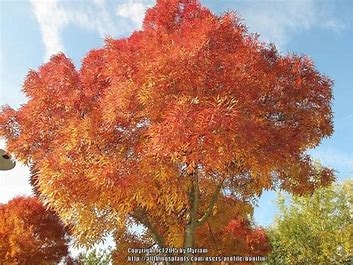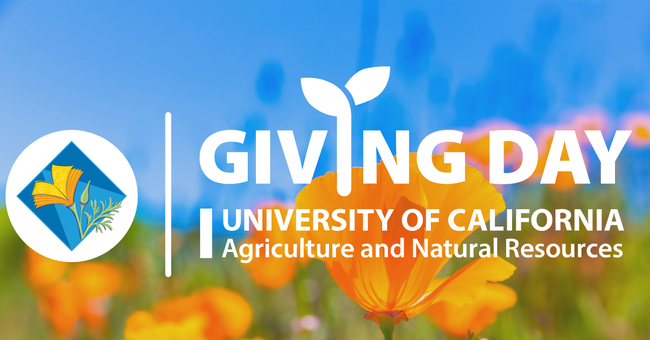Posts Tagged: uc
Fall Colors Explained
Welcome to Fall!
It's my favorite season and likely for many of you, as well. Beyond the holidays and extra time with family and friends, nature radiates its beautiful hues. In addition to lovely foliage, deciduous trees often expose exquisitely shaped and sturdy trunks. And, of course, there is the lovely fall foliage showcased by many species.
Did you ever wonder why trees "turn" color in the fall? The short answer: It's primarily a function of long, cool fall nights and short, sunny days. The longer answer? Chlorophyll is responsible for the basic green color of leaves we see in spring and summer and is a necessary component of photosynthesis, which uses sunlight to manufacture sugar (food) that is stored during the dormant period of the year. Carotenoids produce yellow, orange and even brown pigments in crops such as carrots, squash, bananas and many ornamental plants such as daffodils and poppies. Anthocyanins are red and orange in color and are most linked to lavish displays of brilliant fall foliage. They also give rise to coloring of strawberries, plums and cherries.
Here's the kicker: While chlorophyll and carotenoids are present in leaf cell chloroplasts throughout the entire growing season, during fall chlorophyll begins to break down. Voila! The lovely yellow and orange hues we all look forward to seeing are finally exposed. In addition, red hues (called anthocyanins) are produced in fall. So, in reality foliage doesn't "turn" orange or red at all.
Interestingly, the actual timing of color change varies across species and appears to be genetically inherited. The same species will exhibit a similar color scheme in cool temperatures in higher elevations at nearly the same time as it does in warmer lower elevation climates.
The intensity of color can vary quite a bit however. Where do temperatures enter the picture? Both the amount of color and the overall intensity of fall color is very linked to weather conditions that occur prior to and during the actual time the chlorophyll in leaves winds down. The most brilliant displays occur after several warm, sunny days and cool, crisp (above freezing) nights. This is because although lots of sugars are made in leaves during sunny daytime hours, the corresponding cool nights prevent the sugars from moving out. The amount of soil moisture also helps ensure that from year to year fall colors vary even in the same trees. So, either a late spring or a prolonged drought can both delay the display of fall color by a few days or even a few weeks.
What's the recipe for the most brilliant fall display? Most likely a warm, moist spring followed by a warm summer and sunny fall with cool autumn nights. Although fall color is not nearly as spectacular in lower elevations of Southern California compared to other colder areas of the nation, the liquidambar or American sweet gum (Liquidambar styraciflua) offers some pretty impressive fall color and an impressive 300 to 400-year life span. (Did you know that liquidambar got its name because it at one time was a sought-after chewing gum for Native Americans?)
Two “climate-ready” tree species with lovely fall foliage that grow in both the west portion of the county and the desert are the ‘Keith Davey' Pistache, a large street and park tree sporting crimson to scarlet colored foliage and its relative, the ‘Red Push' Pistache, a hybrid between P. atlántica x P. integerrima) which has lovely red foliage as it emerges in Spring as well as Fall. Others include the Raywood Ash (Fraxinus oxycarpa 'Raywood') sporting a reddish-purple hue in the fall, and the ‘Sunburst' Locust (Gleditsia triacanthos var. inermis 'Sunburst') which offers a vivid display of fall color. Unfortunately, it is susceptible to the Invasive Shot-Hole Borer. If you have one of these lovely trees already, take good care of it to help it stand up to this aggressive pest!
Happy Fall! Enjoy the cooler weather, family and friends, and lovely trees!

Raywood Ash source national gardening association
Invasive Spotlight: Spotted Lanternfly
The Spotted Lanternfly (SLF) is an invasive pest that poses a great threat to California's agriculture. It was first discovered in the U.S. in Pennsylvania in 2014 and has since taken the east coast by storm, causing damage to many plant species and proving to be difficult to control. Although this pest hasn't been found in California, it is important to keep an eye out to catch an invasion early.
What does the spotted lanternfly look like?
The SLF adult is about 1 inch in length with grayish wings, black spots, and red hind wings. Egg masses are laid in the fall on the east coast and resemble splotches of mud. They are often laid on smooth surfaces like branches, rocks, or outdoor furniture. Early nymphs are very small, wingless, and black with white spots. The last nymphal stage is 1/2 inch long and red with white and black markings.
What damage does the spotted lanternfly cause?
On the east coast, the spotted lanternfly's preferred host is the invasive tree-of-heaven (Ailanthus altissima), but it will also feed heavily on grapes, maples, willows, and birch trees. SLF feeds on plant sap and excretes honeydew, which can cause sooty mold to grow on leaves and fruit. It is known to kill black walnut saplings, tree-of-heaven, and grapevines. However, for most other plants SLF is considered a plant stressor and healthy plants can usually tolerate feeding.
What can you do to help keep the spotted lanternfly out?
Spotted lanternfly is easily transported to new areas as egg masses on firewood, stone, cars, and furniture. Check vehicles and trailers when traveling to areas where SLF has been confirmed. Inspect items purchased or shipped from these areas, and don't move firewood. Familiarize yourself with the various ways that SLF egg masses may appear and report any potential sightings to the CDFA Pest Hotline: 1-800-491-1899.
If you want to learn more, visit the UC IPM Spotted Lanternfly page and consider taking the California Master Gardener Spotted Lantern Fly training module.
Dig Deep and Support Sustainable Gardening on UC ANR Giving Day!
It's time to come together and support the UC Master Gardener Program's mission, mark your calendars! On May 18-19, from noon to noon the UC Master Gardener Program is launching its statewide giving day, UC ANR Giving Day. This special event invites you to join hands and contribute to our mission of extending sustainable gardening practices to thousands of community, school, and demonstration gardens across California. By donating to the UC Master Gardener Program, you can help bring the knowledge and resources of the University to your local community.
Get ready to dig deep, spread the word, and make a difference!
As gardeners, we understand the importance of sustainable practices in nurturing green spaces and preserving the natural environment. The UC Master Gardener Program has been at the forefront of promoting sustainable gardening for decades, empowering individuals and communities to cultivate vibrant and resilient gardens. By supporting the UC Master Gardener Program, you contribute to the advancement of sustainable gardening practices throughout the state, fostering healthier gardens and communities.
UC ANR Giving Day offers various ways for you to show your support and get involved. Whether you are an avid gardener, a passionate environmentalist, or simply someone who recognizes the value of sustainable practices, there's a place for you in this collective effort.
- Make a Gift:
Visit donate.ucanr.edu/givingday during the 24-hour giving day on May 18-19 (noon to noon). Every donation, regardless of size, makes a significant impact on the UC Master Gardener Program's ability to continue its valuable work. Whether you contribute $5 or $500, your support helps fund educational resources, outreach programs, and training opportunities for dedicated UC Master Gardener volunteers who drive sustainable gardening efforts across the state. - Help Spread the Word:
Mark your calendar and spread the word about UC ANR Giving Day! Share the event details with your friends, family, and fellow gardening enthusiasts. Encourage them to join you in supporting this important cause. Together, we can create a ripple effect of positive change by raising awareness and inspiring others to get involved. - Engage on Social Media:
On May 18-19, be part of the excitement by joining in the conversation on social media. Use the hashtag #GivingDay to share your support for UC ANR Giving Day. Let your online community know why sustainable gardening is important to you. Together, we can amplify our message and inspire others to take action.
UC ANR Giving Day is an opportunity to unleash the power of giving and support sustainable gardening practices across California. By supporting the UC Master Gardener Program and UC ANR, you contribute to the extension of knowledge and resources to communities across California. Remember to mark your calendar for May 18-19, and join in the celebration of sustainable gardening. Let's dig deep, donate, spread the word, and make a lasting impact together!
To make your contribution and learn more about UC ANR Giving Day, visit donate.ucanr.edu/givingday.
Wildfire Preparedness Week 2023: Preparing Home Landscapes for Wildfire
It's California Wildfire Preparedness Week 2023 (May 1-8), it serves as a crucial reminder of the importance of preparing home landscapes to help mitigate wildfire risks. With the increasing threat of wildfires in California, adopting preventive measures and adapting landscapes can significantly reduce the vulnerability of homes and communities.
UC ANR fire and natural resource advisers developed strategies for homeowners to make adjustments for a home that is more resilient to wildfire.
Design and implement a defensible space:
- Create fuel breaks surrounding your house and within your garden.
- Create space vertically and horizontally via plant placement and pruning.
- Use hardscape and noncombustible materials around structures and to separate individual plants and groups of plants.
- Use the right plants in the right places with fire, climate, and irrigation needs in mind.
- Create plant islands that have similar sun, nutrient, and water needs.
- Replace combustible gates that attach to the house with materials that will not burn.
Maintain your landscape:
- Keep your garden free from dry and dead wood, dry grasses, and leaf litter, especially near any structures.
- Prune plants to provide horizontal and vertical space throughout your garden and surrounding structures.
- Eliminate fire ladders. A grass fire can move up into shrubs and then into trees.
- Hydrate plants with a water-wise irrigation system. Use non-combustible mulches near the house.
Fire-resistant landscaping is a critical aspect of wildfire preparedness. The UC Master Gardener Program plays a vital role in educating and assisting Californians in creating fire-resistant landscapes and implementing best practices to protect their properties. UC Master Gardener volunteers help guide homeowners in designing and maintaining their landscapes to reduce fire risks. Planting fire-resistant ground covers, shrubs, and trees, as well as maintaining proper spacing between plants and removing dead vegetation can significantly minimize the spread of wildfires.
California Wildfire Preparedness Week 2023 serves as a reminder of the importance of creating fire-resistant home landscapes to protect our communities from wildfires. UC Master Gardener volunteers help provide education and assistance to homeowners through community workshops, webinars, and other outreach events. For information on an event or workshop near you connect with your local UC Master Gardener Program by visiting: https://mg.ucanr.edu/FindUs/.
By working together, we can foster wildfire preparedness and resilience, ensuring the safety of our communities in the face of increasing wildfire threats!
Resources:
- UC ANR Fire in California, https://ucanr.edu/sites/fire/Prepare/
- Ready for Wildfire: http://ReadyForWildfire.org
New Year, New Garden! January Gardening Tips
Happy New Year from the statewide UC Master Gardener Program. Gardening in January can be a challenge with the cold weather and shorter days. However, January can be an excellent month for garden maintenance and preparing your landscape for spring and summer.
From giving your garden a makeover to planning for a vegetable garden, there are endless opportunities to stay active in the garden in January. What steps can you take to improve your garden this month? Here are a few tips to get you started:
- Watch weather reports. Accordingly, protect your plants from frost and other weather conditions. Cover them when necessary and adjust watering both for cooler temperatures and for seasonal rains.
- Don't forget about your houseplants. Make sure to keep your houseplants watered, as they tend to dry out from indoor heating during the winter months.
- Clear dead plants and debris. Give your garden a clean look for the New Year and allow more space for new growth. Don't forget to pull out weeds.
- Keep your garden tools sharp and clean. Avoid rust and dullness and prepare for the pruning that takes place in January and February.
- Prune dead or damaged branches. Since January is the dormant season, it is the ideal time to prune. Prune your fruit trees while avoiding apricot and cherry trees. For more instructions on how to prune, check out this pruning guide.
- Start your vegetable garden indoors. Expand your growing season and start seeds, you can plant cabbage, chard, broccoli, cauliflower, and spring lettuce, to name a few. You can also start them in a cold frame or greenhouse.
- Plant flower bulbs. Get a jump start on planting flower bulbs this month, which can lead to a longer spring bloom!
- Plan your spring and summer vegetable garden. Design a garden plan now to prepare for spring planting. A great first step is to draw a map of your garden on grid paper and consider which seeds you want to plant and where.
January is a time of new beginnings, including in your garden. By preparing now, you can expect fantastic results in the spring and summer months.
Ask your local UC Master Gardener Program
January can be an unusual time in the gardening world, but we are here to help. For more gardening help and local county resources, click here to Find a Program. You will be redirected to your local county website and contact information. UC Master Gardener volunteers are available to help answer questions for FREE about your garden.








